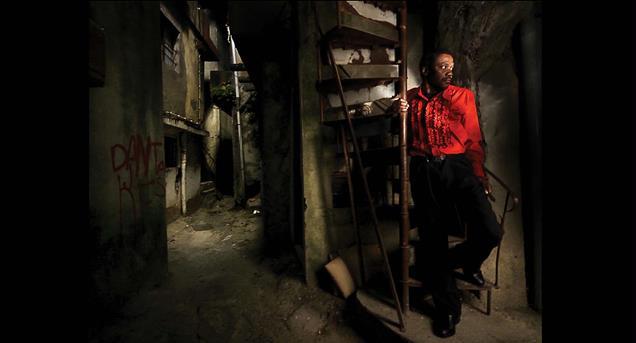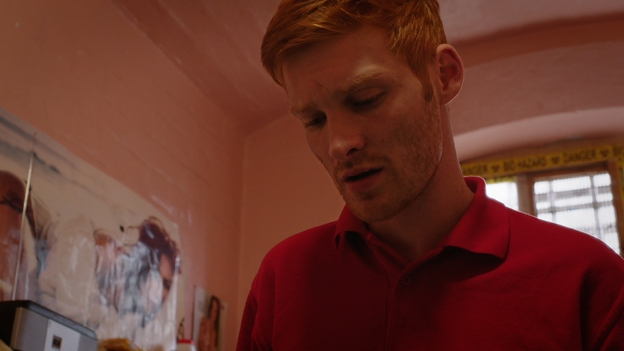CPHDOX is amazing at blurring the boundaries between documentary, art and fiction, showcasing hybrid films as well as putting stuff in other contexts. But then, at times, because the festival overall is so amazing at considering docs as an artform, the series devoted explicitly to art-films might suffer. When amazing art-cinema like Lav Diaz' Storm Children or Pedro Costa's Horse Money is playing in the main competition, it's reason for aplause, good for not keeping artfilm confined to a ghetto of sorts. But the films left behind might suffer a bit.
The Lack is a fine film, but I'm left with the feeling that it's really regular artfilm-making. Working from ideas I gather was gathered from psycho-analysis, the film showcases six women through four dream-like episodes, where their needs, dreams and frustrations are visualized. It's very beautiful, and the sound is great. The first and the third were filmed in Iceland, the second on the Aeolian islands, as a tribute to Michelangelo Antonioni's L'Avventura, also concerned with the appearence of a 'lack' so to speak, though in that case a lacune left by the dissapearing woman. The first episode showed a woman in a white dress waiting for a man, realizing he'd stood her up once again, then driving into a landscape with a gun and shooting at the dress, which had been gifted to her by the untrustworthy man. As this retelling should make clear, it's not the most subtle thing. The other episodes were better, more poetical. One has a woman named Xiu travelling to an island with a heavy projector in tow, carrying it up a hill and creating a beautiful light. Not subtle, but the final light was very very beautiful, and beauty is what this type of film needs. Third episode, back in Iceland, had two women travelling to a floating glasshouse. Fourth episode concerned therapy explicitly, and included some crazy shots of a naked frightened woman going down a dark tube on a stream of water, like a water-slide, filmed from the inside. I can't explain it, absolutely crazy how on earth they did it.
The directors from the artgroup Masbedo were two men. As you can imagine, a film made by men, about women and what they are lacking, is balancing on a knifes edge. The men talked about wanting to show a different type of woman than the 'Berlusconi'-woman dominant in Italy, but it turns out, being a better feminist than Berlusconi might actually not be enough to impress an audience of young Danish women, who had some quite pointed questions afterwards. And the film is a bit weird. Like, it's quite easy to see it as a film about penis-envy... 'Lack' is a Lacanian term, and it can be used quite subtly and universally without much gendering but... Yeah, pscyho-analysis is weird, man.
Horse Money (Pedro Costa, Portugal, 2014)
One of those films that could perhaps have been in the art-category is Pedro Costa's new weird Horse Money. In any way, I don't think it should be categorized as a documentary. The film has been called the fourth film in what is now known as the 'Fontainhas'-tetralogy, which for it's first three films, Ossos (97), In Vanda's Room (00) and Collosal Youth (06), took place in the now demolished Fontainhas slum in Lissabon. But grouping these films together perhaps minimizes the big differences between the four, and naming them all for Fontainhas glosses over how much the films, especially the last two, are concerned with the immigrant experience in Portugal, and the hangovers from Portuguese colonialism, something also present in Costa's Down to Earth from 95. Actually, In Vanda's Room is the only one that seemed truly documentary to me - though it's also the only one of the four I haven't finished, so perhaps it changes after the first half. At the Q&A, Pedro Costa talked about having worked in the same method for 15 years and 3 films, that is after Ossos. And this method - shooting with a minimal crew and on digital, developing films together with his subjects - aren't as much used for documenting raw reality anymore, but for getting into the heads of the subjects of the films, for basing the narrative on their desires, memories, histories. All in all, I feel we might have to reevaluate what Costa has been trying to do, and I also feel that the old narrative of his work has harmed the reception of this new one. Because this new one isn't really a documentary, it's heavily fictionalized and stylized, and it doesn't have a lot to do with Fontainhas, and yet it builds pretty logically on Colossal Youth. But from some of the confused reviews I've read of this film, it doesn't seem as if the critics were prepared for it anyway.
Alas, the film does have it's share of problems, and some of them derives from it's deviation from the earlier films in the trilogy. The loss of Fontainhas is deeply felt. That claustrophobic neighborhood was an extremely filmable location, where the personality of the group of people who'd build it could be sensed almost everywhere. In Colossal Youth, when focus moved to the new, sleek, white apartments that the government would be giving the inhabitants in return for their demolished homes, you could feel the loss of history, and the absence of anything substantial given in return (if there was any sense that living conditions would improve, obviously it would be worth it, but the sense I get is that nothing was done about the root of the problems, it's just that people were moved from a neighborhood where their squalor had become too visible). Horse Money is shot in studios, in abandoned factories, in doorways and elevators, and the visuals don't work like they used to. Not exactly. Costa still uses light better than pretty much anyone, so most of the film is still an aesthetic delight, but there isn't the same sense of lived life in the pictures.
Further creating problems: The film dives deep into the head of Ventura, the lead character of Colossal Youth as well, where he wandered around and talked with his 'children'. This time he's been out in a hospital or prison or asylum, it isn't exactly clear, and he talks as much with doctors, soldiers and specters of his past. Ventura remains a striking presence, though he's gotten much older since last we saw him, and the traumas and losses in his life is interesting to explore, but while there are some other immigrant persons in the film - a woman named Vitalina, arriving from Cape Verde; Ventura's 'godson' whom he sings with a bit - there isn't the same sense of a communal epic being told as there was in the two earlier films. Further exacerbating this problem is the short runtime by Costra's standards, only 105 minutes, hardly enough to establish the landscape where used to from earlier. (yeah, I know: "Such a boring film, and way too short as well!")
I was a bit dissapointed in this film, but understand me correctly: Pedro Costa is one of the most important filmmakers working today, and my dissapointment only means the film is not as good as Colossal Youth, one of the best films of last decade. Horse Money is still a unique experience, extremely beautiful, and important in the way it gives voice to the outcasts and shines a light on history we might want to forget in Europe. The film shines a light on the fact that the Portuguese Carnation-revolution, which toppled the dictatorship in 1974, was done by the same soldiers who'd comitted dreadful atrocities in Angola, Mozambique and Cape Verde, and that this development might have been an extremely frightul one for the immigrants. In a sequence towards the end Ventura is trapped in an elevator with a soldier in full camo gear, whether he considers Ventura fellow countryman or enemy is hard to tell.
It is a good film, one that needs to be seen and discussed, and one that hopefully will help give Pedro Costa, Ventura, and the rest of the Cape Verde immigrants more exposure. But I'd hoped it might be the film of the year, and it's not.



















